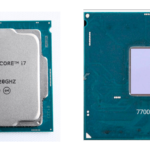If you’ve read our review of the i9-9900K, you’ll find that the processor can easily exceed 90 degrees at full load with a 5GHz OC. The professional overclocker Der8auer discovered why these processors get so hot.
Der8auer didn’t waste any time opening an Intel Core i9-9900K of the ninth generation, a remarkable chip, also because it is the first conventional Intel desktop CPU with 8 cores and 16 threads. The ninth generation Core series also marks a return to the use of a soldered thermal interface material (STIM) between the CPU matrix and the IHS instead of a conventional, low-quality thermal grease. However, Der8auer discovered something interesting that made him wonder whether switching to a soldered solution was really the best move or not?
For those unfamiliar with the concept of destacking, it’s a matter of carefully ripping the IHS out of the CPU matrix, usually to replace the TIM with some liquid metal. Extreme overclockers routinely do this kind of thing, but some enthusiasts do as well, who may not be looking for record speeds and benchmarking results, but still want to improve their processor temperatures.
As for the Core i9-9900K, Der8auer noted that his sample was hotter than expected. So he started with the IHS to investigate. He found that both the metal matrix and the PCB were thicker than the previous generation. So the Core compares i9-9900K to a Core i7-8700K measured by Der8auer:
Metal matrix and PCB are thicker on the Core i9-9900K
- i9 9900K PCB core: 1.15mm
- i7-8700K PCB core: 0.87mm
- Core i9 9900K Matrix: 0.87mm
- Core i7-8700K Matrix: 0.42mm
Der8auer assumes that the additional thickness of the CPU as a whole could affect temperatures. Since the chip is thicker, the heat dissipation is worse. So the famous overclocker polished some of these 0.87mm silicon chips to make them thinner and improve heat dissipation. The results are as follows.

Der8auer was able to reach temperatures of 13 degrees below a soldered i9-9900K by polishing the chip and adding Thermal Grizzly Conductonaut.
It seems that the delidding process has become more complicated with the addition of solder to the mix. Clearly, Intel could have improved processor temperatures with better soldering and thinner matrix and circuit boards. Remember that the i9-9900K processor has a maximum operating temperature of 100 degrees and is dangerously approaching these numbers in OC mode.






Leave a Reply